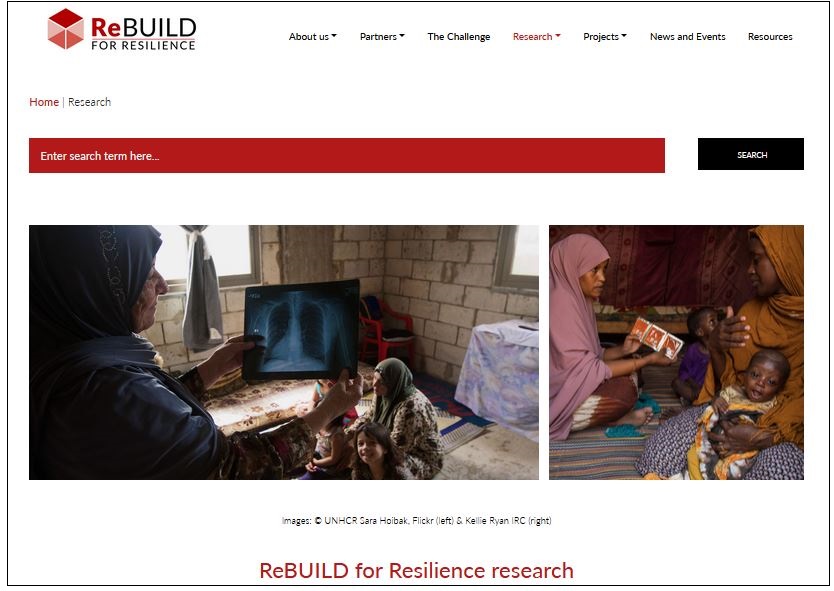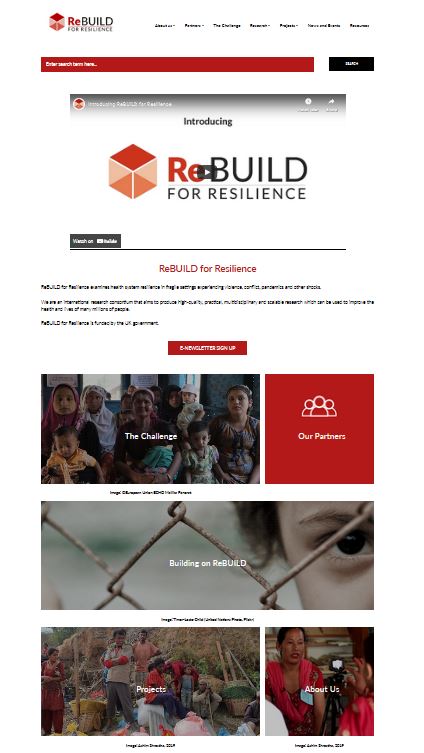
Welcome to our new website
1 March 2021
How do you create a website for an international research consortium? Who and what are your considerations? Are those considerations different to any other website? This was the challenge facing the ReBUILD for Resilience team last year when the consortium (funded by the UK’s Foreign, Commonwealth and Development Office FCDO) was launched. In no particular order, these are some of the main points we considered.
Do we even need a new website?
It’s kind of a given that a project will have an online presence, but do we actually need one? What benefit does it serve? Even a cursory look at the web statistics from our precursor project, ReBUILD, told us ‘absolutely, yes’. Over the duration of the programme (and bearing in mind the gradual evolution of the programme’s social media presence and the content-lean early months) the site welcomed almost 400,000 visitors. Just under a third of site visitors came from low- and middle-income countries – the very stakeholders the programme is designed to reach and influence and a crucial audience in our research uptake plan. Even after the programme ended in December 2018 the site continued to draw a crowd, with about 120,000 visitors accessing resources, blog posts etc. There was obviously a demand.
Also, it might be argued that the internet is a highly democratic medium, and that an informative, accessible, free website working in tandem with strong social media can be a force for good.
So, why not just revamp that previous ReBUILD site? For a couple of reasons…
Accessibility
The old site really wasn’t as accessible as it needed to be. To be honest, the new website has a way to go before it is as accessible as we would like and our visitors require. One of our big considerations for the new site was migrating over the almost 300 briefing papers, reports, videos, toolkits, journal articles and presentations from the existing ReBUILD database. This is vital research that we needed to keep available. However, some of the formatting of documents, subtitling of videos etc isn’t as accessible as it might be, and we are aware that the accessibility of our site is highly variable. We have a plan in mind and will be working towards the AAA accessibility standard.
While this existing ReBUILD content is really important, it is not the work of ReBUILD for Resilience and its partners which brings me to the third consideration…

We are a consortium
As a consortium we need to profile the work of all of our partners, especially the outputs and voices of those in our four study countries. The new site needed to equally represent all partners, so a bolt on to the existing ReBUILD site or a mini-site appended to a partner’s site was not an option for us. All of the partners were involved in the development process – contributing ideas regarding the structure and then assisting with content generation, testing etc – and it is important to us that that collaborative process continues. Our branding, alphabetical profiling etc is all part of that approach.
Photography
It won’t have escaped your notice that many sites use relatively high resolution, full-width images across the tops of pages. These are great – impactful, colourful and can tell a great story. However, we’re also aware that many of our researchers are taking photos on older phones, on the hoof and in dark meeting rooms. We know from experience that not all of our imagery is going to be of a size and impact that lends itself to such large photos, and so the flexibility to change our layout and feature smaller images was really important to use – hence our ‘boxy’ homepage and other pages. This also gives us a lot of flexibility with regard to layout, and, again, is not an option we’d have had with a rebranding of the old site or pages on a partners’ site.
The site structure
Any website comprises layers of information – usually from the general to the specific, drawing the visitor deeper into the site. We are aware that some of our visitors know exactly what we are about and are expert in their fields. However, others will be policy makers, students, health workers, or working in allied fields and therefore need a more general introduction with the opportunity to explore more. We spent a lot of time thinking about who would visit our site, what they would be looking for, and the structure and content that might best serve them. The site you see now will evolve and expand as the research programme progresses. This is linked to the other major consideration…
The new resources database
Again, how should we structure the new resource system? How can we fuse existing ReBUILD resources with future ReBUILD for Resilience outputs? How will people find what they are looking for and how can we tell them what we have? These are all questions to which we gave a lot of consideration.
Get in touch
We would love to hear what you think about the site and how you would like to see it develop. Get in touch via our contact page.